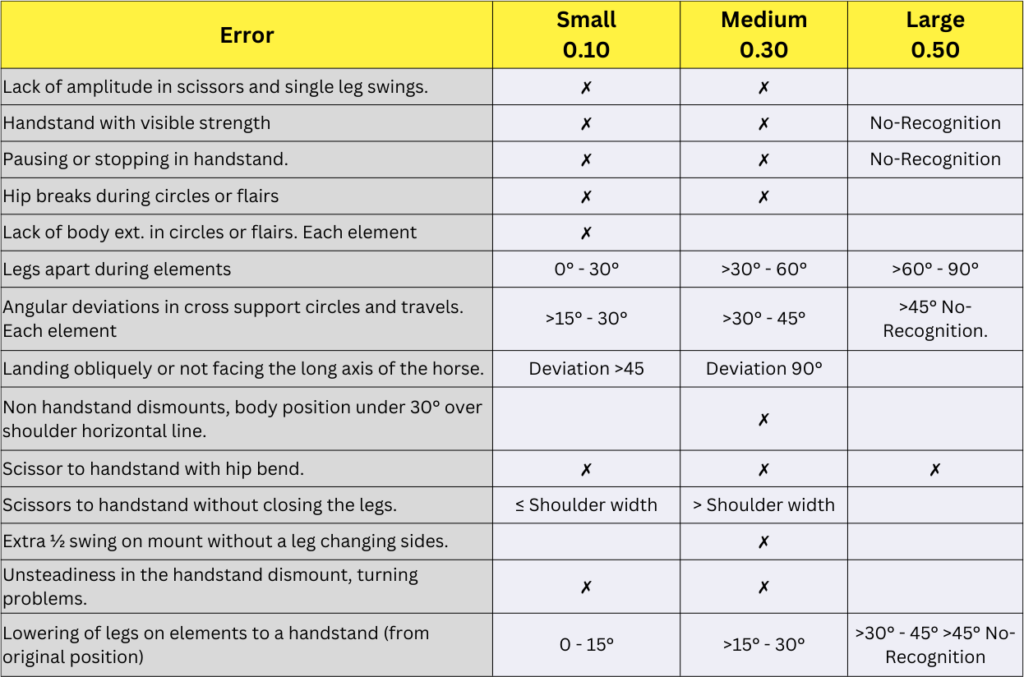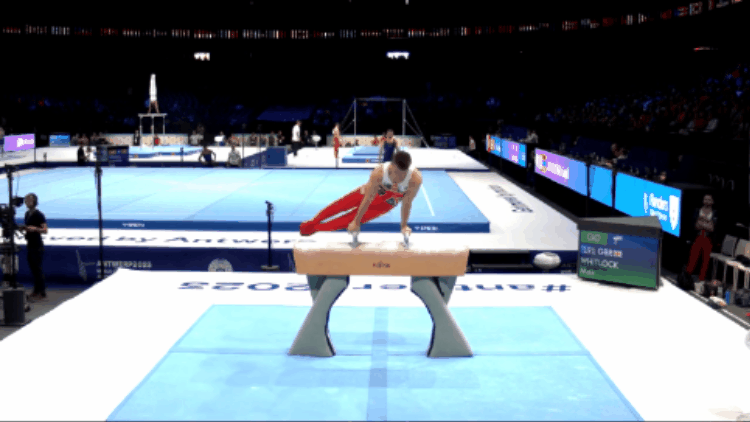The pommel horse is one of the most challenging apparatuses in gymnastics, demanding strength, precision, and flawless execution. But even the smallest mistakes can lead to big deductions, costing gymnasts valuable points. Whether you’re a gymnast looking to fine-tune your routine, a coach aiming to help your athletes avoid common pitfalls, or a spectator looking to learn more about the sport, understanding the most frequent errors and how to correct them is crucial.
In this article, we’ll break down 13 pommel horse deductions judges specifically look for, so you can avoid them for a cleaner, higher-scoring performance.

Pommel Horse Circle and Scissor Position Deductions
1- Piked Circle Positions
The circle is the foundation of pommel horse, and judges closely inspect the position of each circle a gymnast performs. The ideal circle position in gymnastics is keeping the chest and hips extended in a parallel plane, but this is quite challenging to do. In practice, slightly rounded shoulders with a hollowed chest and small hip bend will still avoid deduction.
An example of this slight rounded position is Max Whitlock’s circles:

However, any further rounding of the shoulders, hips, or chest will accrue a lack of extension deduction of -0.1.
2- Circle Skew
A circle also requires shoulders to be squared up with the horse. When the shoulders or hands tilt diagonally across the horse, a gymnast can pick up skew deduction.
Skew deductions are -0.1 for 15° – 30° of deviation, -0.3 for 30° – 45° of deviation, and loss of credit for the skill past 45°.
Generally, judges look for skew in both the hands and the shoulders. So even if the hands are in line with each other, the shoulders may be tilted.
Skew occurs most commonly with traveling elements like Magyar and Sivado, but also can occur during transitions from skills. For example, when performing 1/4 turns into and out of loops, gymnasts often skew to start the turn earlier or shorten the turn into a skewed loop.

3- Lack of Scissor Height
A primary benchmark judges have for scissors is leg height. Judges look for the foot of the leg swinging up to go above shoulder height. A leg swing below shoulder height would be a small deduction, and below hip height would be a large deduction. This applies to all EGI- single leg and scissor skills.

Developing outstanding scissors will help avoid lack of amplitude and other scissor deductions on pommel horse.
Common Horse Deductions
The most common pommel horse deductions fit into a few categories: hip breaks, scrapes and hits, single-leg rhythm mistakes, and general form errors.
4- Hip Breaks
Hip breaks are any deviation in the hips from the previous circle position. For example, a circle may be completely extended for the first half, but pike on the second half coming back to front support for a hip break error.
However, if a gymnast maintains the same position the whole circle, even if slightly piked, there is no hip break deduction.
Hip breaks are more common than circle shape errors, and they are easy to spot. They can be categorized into small (-0.1) and medium (-0.3) deductions.
5- Scraping and or Hitting the Horse
Scraping or hitting the horse are both noticeable errors since they can be easily seen and heard.
A scrape is -0.1, while a hit is -0.5. A hit differs from a scrape in that a hit changes the gymnast’s momentum. Also, a hit is much louder than a scrape.
Judges often ignore light contact with the horse as incidental for light brushes on scissors, due to the nature of scissor elements. However, they will still deduct if the level of contact with the equipment is large enough.
6- Sitting or Stopping on Scissors
Judges evaluate scissors for rhythm, so any pauses or stops get deducted.
In particular, scissor hops or traveling scissors can lead to deductions if not done right, especially at the catch. Hitting the horse can result in deductions of (-0.1) or even (-0.5), while completely sitting out of the hop is considered a fall, with no credit for the skill.
To avoid this, gymnasts should maintain rhythm out of the catch and remain elevated above the horse.
7- General Form
Bent leg, toe point, and leg separation all are classic general form deductions across events. Common mistakes on horse include a knee bend at the third quarter of a circle, small toe and leg separations on circles, front knee bend on single leg skills, and flexed toes during singe leg skills.
Like on other events, these errors are graded as small (-0.1), medium (-0.3), or large (-0.5)
Pommel Horse Dismount Errors
8- Handstand Dismount Mistakes
Handstand dismounts have a large variety of possible deductions, and it is quite easy to pick up these deductions. At the junior level, handstand dismounts typically start with a -0.8 deduction, often for:
- (-0.5) hitting the apparatus or lowering the legs on swing to handstand AND
- (-0.3) using strength to press up to the handstand.
When these deductions are severe enough at the senior level, the gymnast loses dismount credit.

Source: the15366.com
Additional common deductions include:
- Lowering legs during the press (-0.1, -0.3, or -0.5 depending on angle).
- Visible struggle to maintain the handstand or showing a stop before pirouetting or dismounting.
- Handstand must pass through a vertical plane to get credit and avoid deductions. If the gymnasts dumps the dismount and misses the handstand, no credit will be given.
- Poor rhythm in a handstand pirouette (-0.1 or -0.3) or coming down on the wrong side of the horse (-0.3). Referred to as “turning problems”. Also, judges don’t upgrade the dismount from the pirouette if the gymnasts comes down on the wrong side of the horse.
- Not landing parallel to the horse’s length (-0.1 to -0.3).
Because of the variety of possible deductions and difficulty of the skill, handstand dismounts often lose anywhere between -0.6 to -1.2 in deductions. Senior and Elite gymnasts face the same challenges on handstand dismounts but usually get fewer deductions as they execute better.
9- Russian Wende/Flank Deductions
The most common deduction for Russian dismounts is a low flank off. Judges evaluate body angle on the flank off as follows:
- Any body position <30° results in a (-0.3) deduction.
- The angle measured is between the hips and the shoulder line, not the feet (meaning you can’t aggressively arch to save the deduction).
A common issue for juniors is confusing a regular flank-off with a Wende flank-off. To get dismount credit, you have to start the flank from front support on the end of the horse and go up and over the horse before landing.
Easy To Fix Mistakes on Pommel
There are a few deductions gymnasts have in their routines that are quite easy to fix. Some of these are focus errors and are quite simple mistakes.
10- Beginning routine with legs apart
- When mounting the horse, you have to jump to the horse with your feet together on the floor.
- Feet can start apart on the floor as long as they come together before starting.
- -0.3
11- Extra leg swing when mounting
- When mounting into a scissor, you have to jump right into the scissor.
- You cannot start with a swing one direction, before swinging back the other way for the first skill.
- -0.3
12- Leg bend and/or hitting the horse on a circle pickup from leg work
- When cutting into circles from single leg skills, gymnasts often bend their front leg and use it to push off the horse to propel their circles.
- Usually, -0.1 for the hit and -0.1 or -0.3 for the leg bend.
13- Leg Height on Leg Cuts
- Just like scissors, the rising leg must pass above shoulder height for no deductions.
- Gymnasts often perform simple leg cuts forgetting that they are evaluated, so they ignore height and amplitude.
- -0.1 or -0.3 depending on severity.

